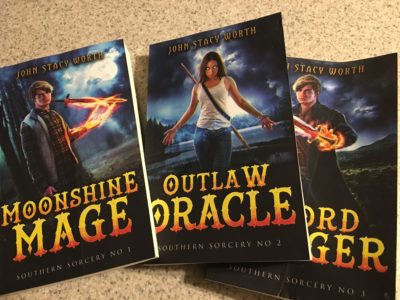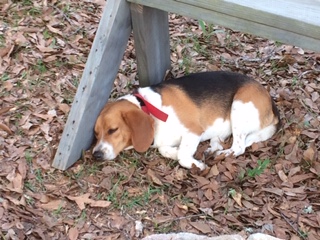One of my main goals is to give readers incredible value when they purchase my books. So with that in mind, I’m writing this announcement to let everyone know I’ve just dropped the price for all three ebooks in my Southern Sorcery series.
There are a few reasons for this. After several months I’ve finally gotten the first three books in this series formatted for print. With the added revenue (which I’m expecting to come with the availability of the print versions), I can now make a permanent drop in the price of the ebooks and not see a dramatic loss of income.
Just a few tidbits to let you know; In case you’re interested in buying a print version, these are 5 x 8 paperbacks 240 to 260 pages long. The price for each is $10.99 on Amazon. Very reasonable.
As for the price drop on the ebooks. I just set each one to $2.99. It may take a few days for all three to show the updated cost, but as of the time of this post, book 1, Moonshine Mage, is reflecting the $2.99 price.
I’ve mentioned this in the past, but in case new readers are wondering why I do it this way, here’s why: Amazon structures their royalty payouts to authors so that I get 70% on any ebook priced over $2.99. In other words, I make about $2.05 per ebook sale.
With the print versions, I’ll make about $2.00 per copy at the $10.99 price. This is because Amazon has to cover the printing cost and still make a profit. I set it so that I make about as much profit as Amazon does, which seems fair to me. It’s set up so that everyone benefits. (Note – if I ever decide to sell direct, it will probably only be for electronic copies. The cost of keeping inventory or doing print on demand for each book just makes it too expensive for me to make any reasonable profit selling print books myself. At least that’s the reality of printing costs today.)
And here’s something I used to struggle with, but have since come to view a little differently: Readers who purchased at an earlier date paid more for my ebooks. Is that really fair?
I had to ask myself this question because there’s something in me that hates injustice. I don’t like it when I see greed or see people ripped off or taken advantage of. I don’t like it for consumers (of which I am one). Neither do I like it for producers (of which I am also one). As an artist, I never want to price my work too high or too low. I want a fair deal for my readers and for me.
Unfortunately, a lot of artists and writers undervalue their work because the mass market has made many folks balk at paying for original art (I mean, why pay $300 for an original oil painting when I can get a framed print for a fraction of that price.)
As an author, it’s even harder. Especially when you consider that an ebook is a digital asset. The value is only in the story on the page, or in the case of an ebook — in the pixels. I may set temporary price drops to $0.99 (the lowest that Amazon allows, with the exception of permanently free books that must be free elsewhere before they will price match), BUT I don’t usually set a $0.99 price for long.
So where is the right price point for an ebook? It depends on a lot of things, but really I think it’s a matter of what readers are willing to pay and what the author thinks is fair. For me, I’ve found that starting around $3.99 and then dropping to $2.99 later on feels right. As I said, I struggled for a while, but then I had a fellow author explain it to me this way:
This friend informed me that pricing my ebooks higher to begin with would give me enough profit early on to keep up with the costs of doing business (paying for cover art, website hosting, domain names, advertising costs on Amazon and Facebook — really all the things an independent author has to do to gain visibility and sell books). Then later, when those costs were covered and there was money in the bank, I could afford to drop the price, but should still be compensated for the hours of work that go into crafting a novel.
That made a lot of sense to me. I also think of it in terms of movies. When a new release hits the theater I expect to pay full price. Six months later I can rent it on Redbox at a fraction of the cost. You get the picture.
Here’s a sad but kind of funny story before I end this post. Before making the print versions available to the public I wanted to make sure that they looked okay. You know, have good color on the covers and interior print that was easy to read, all that. Well, I ordered 2 copies of each so I could inspect the print copies first hand and make sure everything was presentable.
What I didn’t count on was Dixie, my youngest son’s beagle. She’ll turn one year old in a few weeks and is still at the stage where she likes to chew things to shreds.
Yeah, she got to the Amazon package before my wife did. As a result I’ve got four books that are readible, but none that are exactly presentable. I did find that if I layered them in a certain way, I could take a photo to show that the covers look fantastic and the printed versions were ready. There is actually only one book that survived unscathed. A lone copy of Outlaw Oracle. But here is a photo of a carefully arranged set of books that I posted on Facebook:

What you can’t see are the chewed up corners on two of them and ripped back cover of book 3. Oh well. Live and learn. (I still love you Dixie!) We did opt to buy a large delivery container for the UPS and Fedex drivers, so this shouldn’t be an issue going forward.
Now excuse me while I get back to writing book four.
Peace and thanks for reading,
John Stacy Worth
